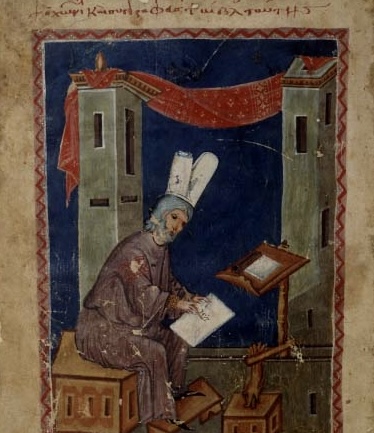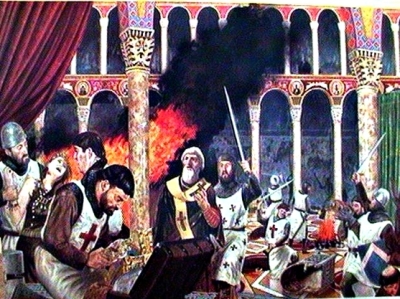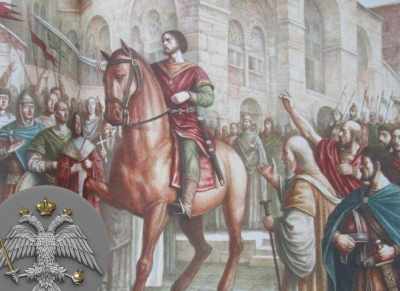
During the reign of Andronikos Komnenos (1183-1185) things were going poorly for the Romans. Now, a new major threat emerged. The Normans had returned, coming at a bad time for the Romans as they always did. The prelude to the destruction of Constantinople in 1204 was the Norman sack of Thessaloniki in 1185AD, making this an important event. It is the vidid and tragic warning about what was coming to the Romans which they did not properly see and react to.
THE NORMAN INVASION:
In the summer of 1185 a Norman fleet which had 220 ships sailed from Italy and took the important Roman city of Dyrrachion in Epiros on June 24. This city was a crucial point of defense for the Balkans against Western threats. The Normans had a pretender to the throne, a Roman they claimed was Alexios II. However, considering Andronikos had murdered the young boy this is implausible. This invasion was becoming a startling success for the Normans. On August 6, they reached Thessaloniki, arguably the second greatest Roman city. In just a few years since the death of Manuel Komnenos, imperial military organization was failing on a grand scale.

While the Norman army besieged the land walls of Thessaloniki, the Norman fleet sailed around Greece to arrive on the scene on August 15. On August 24 the Normans breached the walls and the city’s defenses collapsed. David Komnenos, the man in charge, had put up a terrible defense and thus allowed the Normans to undermine the wall. Hell was going to be unleashed in its residents as a result.
THE HORRORS:
Both Niketas Choniates and Eustathios of Thessaloniki recount the horrors the Romans suffered. It is a barbaric tale full of misdeeds, suffering, & humiliation.

Niketas Choniates said that “every house was robbed of its contents, no dwelling was spared, no narrow passageway was free of despoilers, no hiding place was long hidden. No piteous creature was shown any pity…but the sword passed through all things, and the death-dealing wound ended all wrath. Futile was the flight of many to the holy temples, and vain was their trust in the sacred images. The barbarians, who confused divine and human things, neither knew how to honor the things of God nor to grant sanctuary to those who ran to the temples; the same fate which befell those who stayed in their common dwellings…”
To add insult to injury Choniates claims that “certain men climbed on top of the holy altar…and danced thereon, they sang lewd barbarian songs from their homeland. Afterwards, they uncovered their privy parts and let the membrum virile pour forth the contents of the bladder, urinating round about the sacred floor…” They also “dashed the all-hallowed icons of Christ and his servants to the ground.” The disrespect they showed the Orthodox Christians in this event, and in what was to come in 1204 with the Fourth Crusade, is truly saddening.

Choniates also praised Eustathios, our other source, as “renowned the world over for his learning and virtue” and for being “far superior to others in eloquence and every kind of wisdom.” Eustathios describes terrifying scenes: “the heaping up of dumb animals beside the piles of human dead…A crowd too large to be numbered had streamed together at a single gate, and was struggling to squeeze into it with the hope of escaping, although it was not possible for both those on foot and those who were mounted to pass through it. Then the weight of the crowd that was rushing on pressed upon those who were ahead, and in the rush the former suffered the same fate because of those who again pressed on behind them, and again they could not escape the same consequences. So as they collapsed, a hill of dying men mounted up, all mixed together, humans and horses and mules, the later loaded with the necessities of life for the multitude. And this mound rose up against the fortifications of the city there, almost as if it was one of those ramps which are some times set up before a wall in the course of a siege.” The mixed bodies of these animals and dead civilians were then burned together, adding insult. When the Normans entered the city it “was subjected to the usual ravages of war.” It is true medieval warfare was a terrible thing, though the medieval Romans were not the worst in this regard it cannot be said they never sacked a city either.
Eusthathios particularly decries the murdering of the clergy – “And how many of the laity did they decapitate, even as their mouths were filled with the ‘Kyrie eleison’, asking what was this ‘Kyrie eleison’ and laughing.” You can just picture some psychopathic soldiers here mocking the prayers of the Orthodox as they murdered, raped, and plundered. Eusthathios elaborated on the depravations of the Normans: “And behold the holy women used for lust in the churches and insulted in their chastity; those of whom had taken on the yoke of marriage and those consecrated in their virginity, the brides of God, let them also speak forth against the guilty!” Eustathios says, disturbingly, that these women were were basically passed around by the enemy soldiers to do their vile deeds becoming “as it might be said, shared receptacles of lust, no expression of grief is adequate.” They even broke into the tombs of saints to despoil their graves of treasures Eustathios even says men and women “leaped down from the roofs of their houses in search of death” and “submerged themselves in wells” – “the men from fearing of meeting some other form of death, the women to preserve their self-respect.” What a terrible scene.

You can feel the emotion of Eustathios when he reflects on what happened to his city and how terrible it was to “see Thessaloniki, which once shone so brightly among the other cities beneath the heavens, reduced to her present state. Even her enemies would have prayed not to see her in this condition…Alas for the demon which leaped and trampled so heavily upon the prosperity of such a city, removing it so completely that not a trace was left of its former beauty!”
ANDRONIKOS HAS TO GO:
This was not meant to be a mission just to loot Thessaloniki, the Normans considered this the first step towards the conquest of Constantinople itself. They had what was needed, an army and most crucially a fleet. Many crusading armies had threatened Constantinople before, but without a fleet there was no real chance. This is why the Fourth Crusade would succeed 19 years later. However, the Romans still had a little bit of fight left in them. First though, they needed to get rid of Andronikos.
Andronikos had to retreat from Constantinople, where the people were getting angry. While at a palace, likely one of those built by Manuel Komnenos, he decided to kill more of his enemies. On September 11 he ordered the arrest of Isaac Angelos. Big mistake. Isaac hastily came up with a plan, as he tried to save his life. He mounted his horse and rode through Constantinople, rallying the people to take his side, as he made his way to the Great Church. And it worked. The people of Constantinople joined him at the Hagia Sophia, and proclaimed Isaac as the new Emperor. They used a crown that was allegedly that of Constantine the Great which had been hanging on a chain above the altar of Hagia Sophia.

Andronikos tried to return and take control of the situation, but he had only sealed his own fate. According to Anthony Kaldellis, “Andronikos returned to the Great Palace and even show arrows into the crown from a tower, but realized that the situation was hopeless. Many of his guards melted away. He offered to abdicate in favor of one of his more popular sons, Manuel, but received insults in response. He therefore fled north, in a boat with Agnes (the child-bride he took from his nephew Alexios II whom he murdered), and a concubine, but was intercepted and hauled back. Andronikos thereupon suffered, over the course of many days, a gruesome dismemberment by the crowd, which included the widows of his victims. What was left of him was hung by the feet from a column in the hippodrome.”
STOPPING THE NORMANS:
Ridding themselves of Andronikos was great, but the Normans did not pause the war for the Romans during this time. The Normans were advancing into Thrace, but finally a capable general was given the authority and resources to put up a fight. Alexios Branas was given 4,000 pounds of gold in order to raise the armies that would be needed to defeat the Normans.
And it worked. Alexios Branas defeated the Normans in two battles, and these were decisive victories. The Normans lost so clearly that they did not even try to defend Thessaloniki, they abandoned the city which allowed the Romans to liberate it. The Normans had sent their fleet into the Sea of Marmara, but they too were defeat by the imperial fleet. The Romans wee able to push the Normans totally out, reclaiming the Dyrrachion in 1186. However, the damage to Thessaloniki had been done. And the blueprint for a successful conquest of the Roman Empire was clear to see, and it was only 19 years until it would be completed.
SOURCES:
O City of Byzantium, the Annals of Niketas Choniates
Eusthathios of Thessaloniki: The Capture of Thessaloniki
The New Roman Empire: A History of Byzantium by Anthony Kaldellis
A History of the Byzantine State and Society by Warren Treadgold

